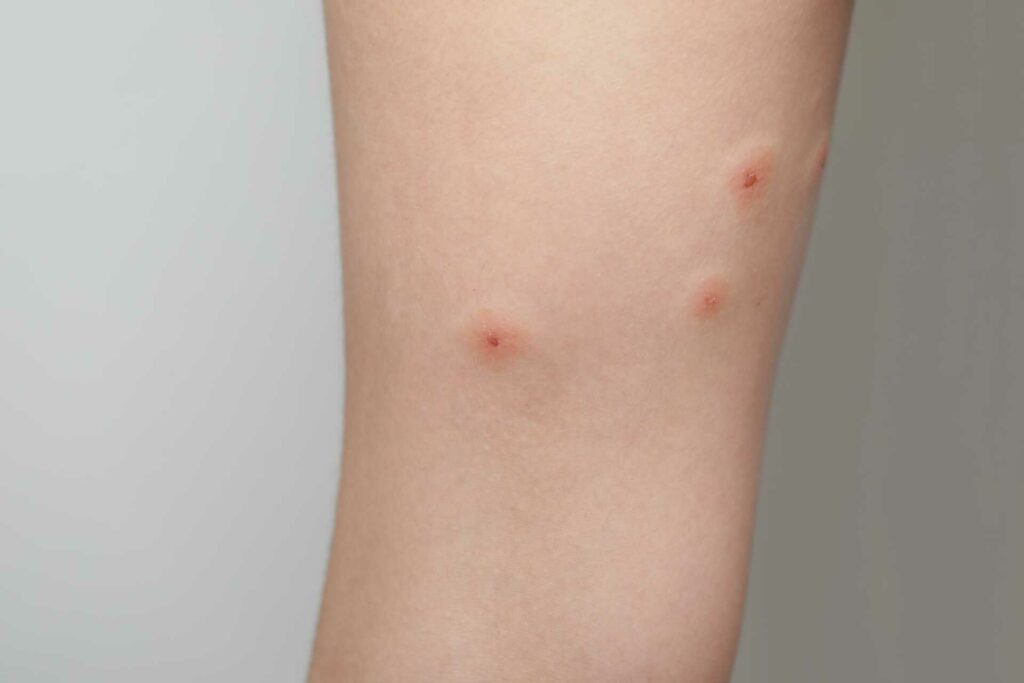
Contents
Protect your home from bed bugs with these seven easy DIY prevention tips. Inspect used furniture meticulously for signs of bugs. Seal cracks with caulk to keep them out. Remember to wash bedding weekly in hot water. Declutter to reduce hiding spots. Invest in bed bug mattress covers for added protection. Vacuum regularly and dispose of debris properly. Keep an eye out for any signs of bed bug activity. Following these simple tips will help you effortlessly maintain a bug-free environment.
Key Takeaways
- Inspect second-hand furniture thoroughly for signs of bed bugs before bringing it into your home.
- Seal cracks and crevices in your home to prevent bed bugs from entering.
- Wash and dry bedding regularly in hot water to deter bed bugs.
- Declutter your living spaces to reduce hiding spots for bed bugs.
- Use bed bug mattress covers to protect your mattress and prevent infestations.
Inspect Second-Hand Furniture
When purchasing second-hand furniture, carefully examine it for any signs of bed bugs. Furniture inspection is vital to make sure you bring home pieces that are free of these unwanted pests. Look closely at the seams, crevices, and folds of the furniture. Check for any live bugs, molted skins, or small black stains which could indicate their presence. Taking preventive measures at this stage can save you from a lot of trouble later on.
Before making a purchase, ask the seller about the history of the furniture. Inquire whether they’ve had any pest issues in the past or if the furniture has been in storage for a long time. This simple step can give you valuable information about the likelihood of bed bugs being present. Remember, prevention is always better than dealing with an infestation.
Consider bringing a flashlight with you when inspecting second-hand furniture. Adequate lighting can help you spot any signs of bed bugs more easily. Additionally, keep a roll of double-sided tape in your bag. If you suspect any traces of bed bugs, use the tape to collect samples for further inspection. By thoroughly examining, you can protect your home and loved ones from the nuisance of bed bugs.
Seal Cracks and Crevices
Sealing cracks and crevices is vital to effectively prevent bed bugs from entering your home. Applying caulk to these openings creates a barrier that keeps bed bugs out and gives you peace of mind. This simple step can make a significant difference in your pest control efforts.
When you seal cracks and crevices, you take proactive measures to protect your home and family from potential bed bug infestations. These tiny pests can hide in the smallest of spaces, making it essential to eliminate any entry points they might use. Using a caulk application effectively closes off these pathways and makes it harder for bed bugs to invade your living spaces.
Pest control experts recommend regularly inspecting your home for cracks or crevices that need sealing. Focus on areas such as baseboards, window sills, door frames, and any other potential entry points. By diligently sealing these openings, you’ll create a strong defense against bed bugs.
Incorporating caulk application into your regular home maintenance routine can go a long way in preventing bed bug infestations. Remember, a little effort now can save you from dealing with a major headache later on. So grab that caulk gun and start sealing those cracks and crevices today!
Wash and Dry Bedding Regularly
Sealing cracks and crevices can only do so much in keeping bed bugs out of your home; therefore, regularly wash and dry your bedding to further prevent infestations. Your bedding provides a vital hiding spot for bed bugs, making it essential to maintain cleanliness to deter these unwanted pests.
Here’s how you can effectively protect your sleeping area:
Wash Bedding Weekly: Routinely washing your sheets, pillowcases, and blankets in hot water can help eliminate any bed bugs present and their eggs. Use a high heat setting in the dryer to ensure thorough elimination.
Use Bed Bug Repellents: To create an additional barrier against these pests, consider using bed bug repellents or sprays on your bedding. Opt for natural repellents to avoid harsh chemicals.
Invest in Mattress Sanitization: Periodically sanitize your mattress using a vacuum cleaner with a hose attachment to remove any bed bugs or eggs lurking within. Consider using mattress encasements to protect your bed from infestations further.
Declutter and Reduce Hiding Spots
Clearing out clutter from your living spaces is essential in reducing hiding spots for bed bugs. By organizing your belongings and embracing minimalist living, you can create an environment that’s less hospitable to these pesky critters. Start by decluttering your home and getting rid of items you no longer need. Not only will this help prevent bed bugs, but it will also create a sense of order and serenity in your living space.
When organizing your belongings, focus on creating designated storage areas for each item. This makes it easier to find things when you need them and reduces the number of potential hiding spots for bed bugs. Consider using storage bins, shelves, and drawers to keep your belongings neatly arranged.
Minimalist living isn’t just about decluttering; it’s also about being intentional with what you bring into your home. Before purchasing new items, ask yourself if you truly need them. By adopting a minimalist mindset, you can prevent clutter from accumulating and make it easier to spot any signs of a bed bug infestation.
Incorporating these organization tips and embracing a minimalist lifestyle can go a long way in reducing hiding spots for bed bugs in your home. Remember, a clutter-free environment deters bed bugs and promotes a sense of peace and belonging in your living space.
Use Bed Bug Mattress Covers
Consider investing in bed bug mattress covers to protect your bed from potential infestations. Mattress encasements are specially designed covers that fully enclose your mattress, acting as a barrier against bed bugs and preventing them from entering or escaping.
Here are three reasons why bug-proof bedding is a smart choice for safeguarding your sleep space:
Prevent Infestations: Bed bug mattress covers create a protective shield around your mattress, depriving any existing bugs of access to you and stopping new ones from settling in. By using these covers, you can greatly reduce the risk of a bed bug infestation in your home.
Easy to Install: These covers are simple and require minimal effort. Just slide the mattress encasement over your mattress like a fitted sheet, zip it closed, and you’re good to go. It’s a hassle-free way to fortify your bed against unwanted pests.
Peace of Mind: Bug-proof bedding offers you peace of mind, knowing your mattress is well-protected. You can sleep soundly, free from the worry of potential bed bug bites or the stressful task of dealing with a full-blown infestation.
Investing in bed bug mattress covers is a proactive step towards maintaining a clean and bug-free sleeping environment.
Vacuum Regularly and Dispose Properly
To help prevent bed bug infestations, regularly vacuum your living space and dispose of any collected debris properly. Pest control experts recommend incorporating vacuuming into your regular cleaning routine as it can effectively eliminate bed bugs at various stages of their life cycle, including eggs, nymphs, and adults. By vacuuming frequently, especially in areas where bed bugs are more likely to hide, such as along baseboards, under furniture, and around bedding, you can greatly reduce the chances of an infestation taking hold in your home.
In addition to vacuuming, proper disposal of the vacuum bag or canister contents is essential in preventing bed bugs from re-infesting your living space. After vacuuming, immediately seal the vacuum bag or empty the canister into a plastic bag, tie it securely, and dispose of it in an outdoor trash receptacle. This step is crucial in ensuring that any captured bed bugs, eggs, or larvae aren’t accidentally reintroduced back into your home.
Maintaining good household hygiene practices, such as regularly vacuuming and disposing of debris properly, not only helps prevent bed bugs but also contributes to overall cleanliness and pest control in your home. By being proactive and diligent in your cleaning efforts, you can create an unwelcome environment to pests, promoting a sense of comfort and security in your living space.
Monitor Bed Bug Activity Regularly
To effectively monitor bed bug activity regularly, inspect common hiding spots such as mattress seams, headboards, and nearby furniture for any signs of infestation. Bed bug detection is vital in preventing a widespread infestation. By being proactive and vigilant, you can catch any bed bug issues early on, making it easier to address them promptly.
Here are a few prevention strategies to help you monitor bed bug activity effectively:
Regularly Check Mattress Seams: Bed bugs often hide in the seams of mattresses where they’ve easy access to feed on you while you sleep. Make it a habit to inspect these areas regularly to catch any signs of bed bugs early.
Inspect Headboards and Bed Frames: Headboards and bed frames provide additional hiding spots for bed bugs. Take the time to examine these areas for any dark spots, shed skins, or live bugs.
Examine Nearby Furniture: Bed bugs can also spread to nearby furniture like nightstands and dressers. Check these pieces for any signs of bed bug activity to prevent them from infesting your entire bedroom.
Final Thoughts
So there you have it: seven easy ways to prevent bed bug infestations in your home.
Following these simple DIY tips, you can protect your home and family from these pesky pests.
Stay vigilant, keep your home clean, and rest easy knowing you’re taking proactive steps to keep bed bugs at bay.
Recent Posts
Why Are Wasp Exterminator Services Priced Differently?
When you consider hiring a wasp exterminator, you might notice varying prices that can leave
10 Tips for Affordable Wasp Extermination Costs
When dealing with wasp infestations, costs can quickly add up if you’re not careful. To
Detailed Wasp Exterminator Service Cost Insights
When it comes to wasp exterminator, understanding the costs involved is essential for effective budgeting.
